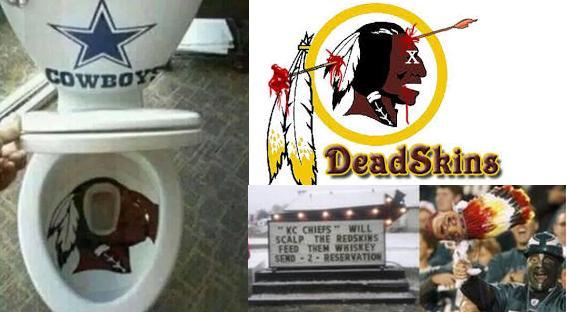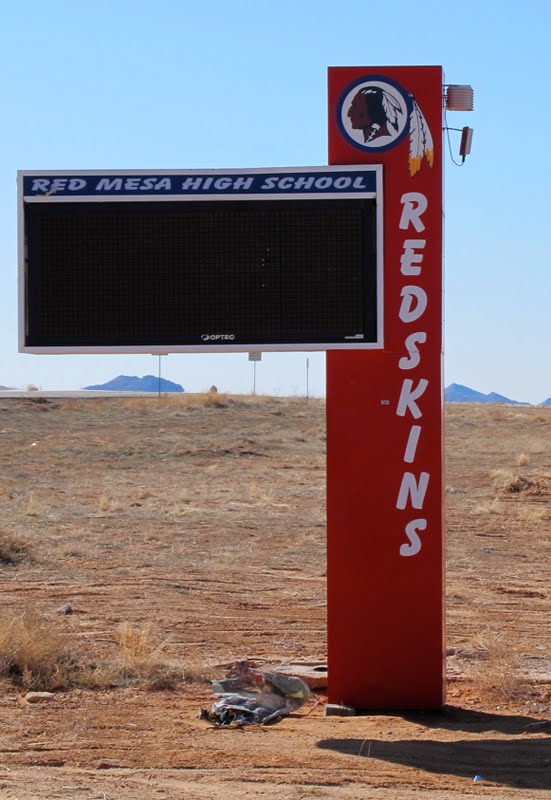Critics have made much of the fact that some Native schools have a Redskins nickname and mascot. For instance:
In Arizona, a Navajo high school emerges as a defender of the Washington Redskins
Dan Snyder and the Navajo Nation: It’s complicated
Red Mesa Navajo High School Moniker Erupts In Redskins Favor Amid Debate
Dear Deeply Offended Redskins Haters: Actual Navajo Nation High School Mascot IS REDSKINS
Note: Love how the right-wing "education editor" in the last article thinks he's telling us something. Actually, the Native use of "Redskins" has been part of the debate for decades.
In her Native Appropriations blog, Adrienne Keene tackles the first article by Washington Post writer Ian Shapira. Her main point is that it isn't just the name, but the effects of the name, that mascot foes object to. Things like this:



Keene goes on to explain how Native schools that use the Redskins name aren't fostering the same racist stereotyping:
Missing the point on the Red Mesa Redsk*ns
This is the context that is important. To be clear, I don’t think that any school should have the Redsk*ns as a mascot.* But I respect the decision of the Red Mesa school officials, given the context of their school.
I also hate the constant dichotomy of rez Natives (therefore the “real” ones) and off-rez Natives on the mascot issue. The reason some folks on the rez don’t care as much (which is also a dangerous stereotype, cause many of the lead activists in this, Amanda Blackhorse included, live on or near reservations) is because they aren’t faced with all these examples I showed above on a daily basis. We in the city have to walk down the street and encounter this racism everyday, and we’re separated from the counter-narratives and counter-representations that would surround us if we lived in our communities. Many of us don’t have easy access to our ceremonies, our aunties, our grandmas, our land–the things that show us we aren’t the harmful stereotypes we see at the sports arena. Folks on the rez do have those counter-examples, surrounding them at all times. Additionally, if you only interact with other Native people everyday, no one is going to call you a redsk*n as a slur.
But those on reservations also have deep, real, and life-or-death challenges, that many of us in urban settings don’t have to face everyday. Which brings us to the “bigger issues” argument. Broken record time, for those who read the blog often:
Yes, unequivocally, we have big things to tackle in Indian Country. We have pressing and dire issues that are taking the lives of our men and women everyday, and I am in absolutely no way minimizing this reality. But we also live in a state of active colonialism. In order to justify the genocide against Native peoples in this country, we must be painted as inferior–that’s the colonial game. These images continue that process. The dominant culture therefore continues to marginalize our peoples, to ignore and erase our existence. We are taught everyday, explicitly in classrooms, and implicitly through messages from the media, that our cultures are something of the past, something that exists in negative contrast to “western” values, and something that can be commodified and enjoyed by anyone with $20 to buy a cheap plastic headdress. These stereotypical images like mascots feed into this ongoing cycle, and until we demand more, our contemporary existence (and therefore the “real” problems in Indian Country) simply doesn’t exist in the minds of the dominant culture.
How can we expect mainstream support for sovereignty, self-determination, Nation Building, tribally-controlled education, health care, and jobs when the 90% of Americans only view Native people as one-dimensional stereotypes, situated in the historic past, or even worse, situated in their imaginations?


No comments:
Post a Comment